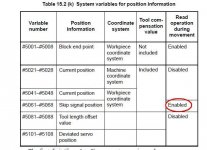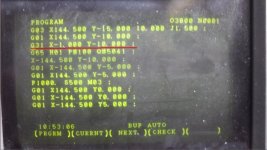Stephan Spears
Aluminum
- Joined
- Apr 12, 2014
- Location
- AB,Canada
Has anyone taken a closer look at the output of G31??
In a scenario where a probe is on the machine which is currently at the position X150 Y0 Z0. Consider the following NC program,
N1 G31 X200. F1000;
N2 #1=#5061;
N3 #2=#5041;
N4 M0;
During the motion of G31, if the SKIP signal is turned on high when the machine reaches X180 physically, the machine will capture system variables #5061, #5041 and save them to #1 and #2.
When the CNC recognize the skip signal, the machine is at 180.003.
When the machine motion stops, the machine is at 182.5.
what are the outcomes of #1 and #2?
Are they
#1 = 180.003 (Current machine position when the CNC recognize the skip signal)
#2 = 182.5 (Machine position when the machine motion stops)
or
#1 = 182.5 (Machine position when the machine motion stops)
#2 = 182.5 (Machine position when the machine motion stops)
??
Thanks in advance.
Steph
In a scenario where a probe is on the machine which is currently at the position X150 Y0 Z0. Consider the following NC program,
N1 G31 X200. F1000;
N2 #1=#5061;
N3 #2=#5041;
N4 M0;
During the motion of G31, if the SKIP signal is turned on high when the machine reaches X180 physically, the machine will capture system variables #5061, #5041 and save them to #1 and #2.
When the CNC recognize the skip signal, the machine is at 180.003.
When the machine motion stops, the machine is at 182.5.
what are the outcomes of #1 and #2?
Are they
#1 = 180.003 (Current machine position when the CNC recognize the skip signal)
#2 = 182.5 (Machine position when the machine motion stops)
or
#1 = 182.5 (Machine position when the machine motion stops)
#2 = 182.5 (Machine position when the machine motion stops)
??
Thanks in advance.
Steph







